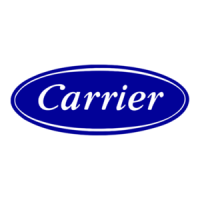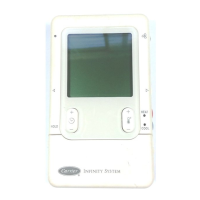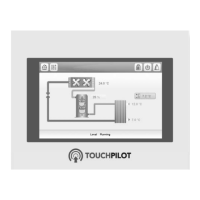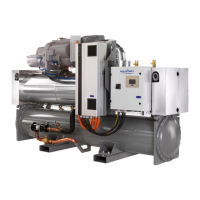100
5.41.2 Liquid Bypass Control for 19XRC
In order to enable a two stage economized R134a chiller to provide a high cooling capacity at low lift
condition, especially in data center application, system needs liquid bypass piping to increase its flow
capability.
The liquid bypass (LBP) will be a standard option of 19XRC for customer when the chiller operation
region has a lower profile than conventional cooling application.
At winter when condenser entering water temperature is very low, the pressure difference between
condenser and evaporator will decrease, which leads to piping flow capacity decrease. In this case, the
liquid may stack in the condenser or the economizer, and it will cause the lack of refrigerant in
evaporator. Subsequently, the evaporator LTD will increase obviously and the chiller may even trip out
due to low evaporator pressure.
The LBP function is designed to avoid above operation failure. It has an electrical modulate (4-20mA)
valve installed in piping proceeding from condenser liquid sump to evaporator inlet.
When chiller equipped with LBP option, should enable LBP function and disable dynamic control
function. When LBP function is activated, closing economizer damper solenoid valve and opening liquid
bypass valve, then chiller will work as a single stage system without vapor supplement at intermedia
stage.
5.41. Dynamic Demand Limit Control
Some 19XRC/F two-stage chiller uses a fixed orifice as high side throttling device. For a fixed orifice, its
flow ability is limited compared with a variable area throttling device such as float ball valve and linear
float valve. Especially when pressure drop between upstream and downstream is lower than design
point, or the chiller operating capacity over the limitation,the flow ability of a fixed orifice will be de-
rated. So if the chiller operates at a low lift, Carrier® SmartVu
TM
needs to limit the cooling capacity by
inhibiting motor run at a high current or limiting input power to prevent liquid choke at high side orifice.
Carrier® SmartVu
TM
have a capacity override limit option in configure menu, available or not available.

